The Poetic Edda: A Study Guide
The Speech of the Masked One
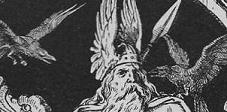
[PREVIOUS][MAIN][NEXT]
[HOME]
|
Codex Regius MS No. 2365 4to [R] |
Arnamagnæan Codex AM 748 I 4to [A] |
1954
Guðni Jónsson
Normalized Text: |
| Heiðrún heitir geit, er stendr höllu á herifadrs, ok bítr af leraþs limum; scap ker fylla hon skal ins skíra mjaðar; knat sú veig vanask. |
Heiðrún heitir geit, er stendr höllu á heria föður ok bítr af læraðs limum; skapker fylla hon skal ins skíra mjaðar; knánn sú veig vanask. |
25. Heiðrún heitir geit,
*Although this name appears in both manuscripts, some editions omit the name for the sake of the meter! |
in Icelandic Poetry
“The Song of Grimnir”
The Yale Magazine, Vol. 16
“The Song of Grimner”
XXV. Heidruna, wildest of the train,
That sport on hill, or russet plain,
Near Odin's hall falacious breeds,
And on the leaves of Lærad feeds.
His spacious horn shall fill the bowl,
That lifts to rapture Odin's soul;
And ever drinking --- ever dry---
Still the copious stream supply.
The goat, which over the hall of Heriafauthr,
Standeth, and nippeth for food the boughs of Laerath,
Is Heithrun; Skaptker daily shall brim with her milk,
The sparkling mead which never can cease to flow.
in Edda Sæmundar Hinns Frôða
“The Lay of Grimnir”
in Corpus Poeticum Boreale
“The Sayings of the Hooded One”
25. Heidrun the goat is called,
that stands o’er Odin’s hall,
and bits from Lærad’s branches.
He a bowl shall fill
with the bright mead;
that drink shall never fail.
20. Heathrun is the name of the goat that stands on the hall
of
the Father of Hosts and bites at the boughs of Learad (a tree). She
shall fill a vat with pure mead which shall never fail.
in Edda Saemundar
“The Sayings of Grimnir”
in The Poetic Edda
“Grimnismol: The Ballad of Grimnir”
25. Sky-bright o'er Valholl stands, the goat,
who gnaws the Shelterer's boughs ;
she fills a bowl with the shining mead :
'Tis a draught which runs not dry.
25. Heithrun is the goat who stands by Heerfather’s
hall,
And the branches of Lærath he bites;
From his horns a stream into Hvergelmir drops,
Thence all the rivers run.
in The Poetic Edda
“The Lay of Grimnir”
in The Elder Edda
“The Lay of Grimnir”
25. Heithrun, the goat on the hall that
stands,
eateth off Lærath's limbs;
the crocks she fills with clearest mead,
will that drink not e'er be drained.
25. Heath-Run is the goat in the hall of All-Father
Who bites at Laerað's boughs:
She shall fill the decanter with clear mead,
That drink shall never run dry:
in Poems of the Elder Edda
“The Lay of Grimnir”
in The Poetic Edda
“Grimnir’s Sayings”
The goat, Heidrun, stands on Warfather’s hall
And bites off Laerad’s branches;
The cask she fills with the clearest mead
can’t be drunk dry.
25. Heidrun is the goat's name, who stands on Father of
Hosts' hall and grazes Lærad's branches;
she will fill a vat of shining mead,
that liquor cannot ever diminish.
in The Poetic Edda, Vol. III
“The Lay of Grimnir”
The Elder Edda: A Book of Viking Lore
'The Lay of Grimnir"
25. Shining Rune is the she-goat's
name
that stands on the Father of Armies'
hall
and browses from Listener's
branches.
She will fill a cask
of the clear mead-
that drink does not run dry.
25. ‘Heidrún is the name of the goat
standing on Host-father’s hall
who bites off Lærad’s [the World-tree?] limbs;
she fills a vat with shining mead
a draught that does not diminish.
[HOME][GRÍMNISMÁL]
1923 Henry Bellows in his The Poetic Edda as
“Grimnismol: The Ballad of Grimnir”:
"The first line in the original is, as indicated in the translation, too long,
and various attempts to amend it have been made. Heithrun: the she-goat who
lives on the twigs of the tree Lærath (presumably the ash Yggdrasil), and daily
gives mead which, like the boar's flesh, suffices for all the heroes in Valhall.
In Snorri's Edda Gangleri foolishly asks whether the heroes drink water, whereto
Har replies, 'Do you imagine that Othin invites kings and earls and other noble
men, and then gives them water to drink?'"
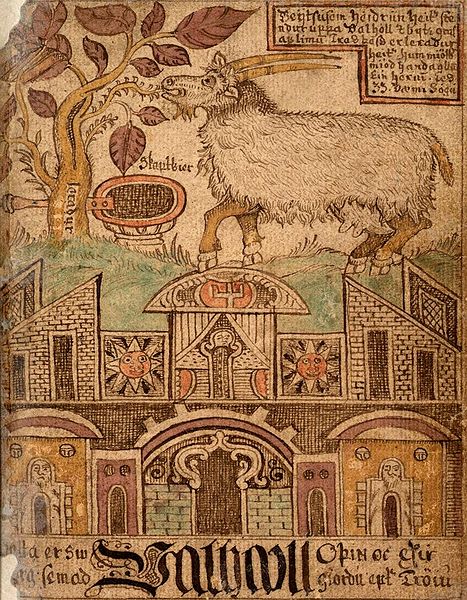
Snorri paraphrases this verse in Gylfaginning 39. His source is clearly Grímnismál 25.
| Þá mælti Gangleri: "Hvat hafa einherjar at drykk, þat er þeim endist jafngnógliga sem vistin, eða er þar vatn drukkit?" | "Then said Gangleri: "What have the champions to drink, that may suffice them as abundantly as the food? or is water drunk there?"' |
| Þá segir Hárr:
"Undarliga spyrr þú nú, at Alföðr mun bjóða til sín konungum eða
jörlum eða öðrum ríkismönnum ok myni gefa þeim vatn at drekka.
Ok þat veit trúa mín, at margr kemr sá til Valhallar, er dýrt
mundi þykkjast kaupa vatnsdrykkinn, ef eigi væri betra fagnaðar
þangat at vitja, sá er áðr þolir sár ok sviða til banans. Annat
kann ek þér þaðan segja. Geit sú, er Heiðrún heitir, stendr uppi
á Valhöll ok bítr barr af limum trés þess, er mjök er nafnfrægt,
er Læraðr heitir, en ór spenum hennar rennr mjöðr sá, er hon
fyllir skapker hvern dag. Þat er svá mikit, at allir Einherjar
verða fulldrukknir af." |
Then said Hárr: "Now thou speak strangely; as if Allfather would invite kings and earls or other men of might to him and would give them water to drink! I know, by my faith, many a man who comes to Valhall would think he had bought his drink of water dearly, if there were not better fare to be had there, for he who had suffered wounds and burning pain unto death. I can tell thee a different tale of this. The she-goat, she who is called Heidrún, stands up in Valhall and bites the needles from the limb of that tree which is very famous, and is called Lærádr; and from her udders mead runs so copiously, that she fills a vat every day. That vat is so great that all the champions become very drunk from it." |
| Þá mælti Gangleri: "Þat er þeim geysihaglig geit. Forkunnargóðr viðr mun þat vera, er hon bítr af." | Then said Gangleri: "That is a wondrous goat for them; it must be an exceeding good tree from which she eats." |
At this point, Grímnismál is primarily concerned with Valhalla, the way leading there and the places and objects found therein. We find a similar scene in the opening strophes of Hyndluljod, There Freyja rides her golden boar to the grave of a volva. She and her boar are on their way to Valhall. Ottar is a human candidate for admittance into Odin's hall. Freyja
accompanies him:
Hyndluljóð:
|
Freyia kvað: Vaki mær meyja, |
Freyja spoke: 1. "Wake maid of maidens, wake my friend, Hyndla, sister who lives in a cave; Now is the twilight of twilights, we shall ride to Valhall and to the holy sanctuary." |
Freyja is depicted riding a golden boar, like her brother Frey's boar, Gullinbursti, made for him by dwarves (Skáldskapamál 43).
|
Nú taktu ulf þinn Hyndla kvað: "Seinn er göltr þinn |
5. "Now take one of
your wolves from the stall, Let him run with my boar." Hyndla said: "Slow is your boar treading the god-road, I would not weary my worthy steed." |
|
Flá ertu, Freyja, |
6. "False art thou
Freyja, when you test me, your eyes reveal the truth, your lover goes with you on the way of the slain, Ottar the young, Innstein's son." |
Hyndla detects Ottar hidden in the form of the boar, calling him Freyja's lover. Ottar is phonetically identical with Oðr, Freyja's husband (cf. Völuspá 25). They are on val-sinne, the 'way of the slain', i.e. the road to Valhalla. The boar on which Freyja rides ("my worthy steed") is Ottar. No doubt a sexual pun is intended. He may also be named in verse 42 (see below).
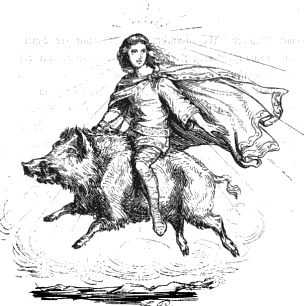
In Grímnismál 18, we saw that the warriors of Valhall (those on 'the way of the slain') are compared to the boar they consume, Sæhrimnir. Both are slaughtered and brought back to life each day. They are an ever renewing supply of meat. Human flesh is the "best of bacons". Odin feeds this flesh to his wolves. 'Food-of-wolves' is a kenning for warrior. The boar and the warrior are symbolic equivalents.
|
Freyja kvað: |
Freyja spake: 7. "You're silly, Hyndla I think you're dreaming when you say my lover is with me on the way of the slain; There shines the boar with golden bristles, Hildisvini, he who was made by skillful Dain and Nabbi, two dwarves. |
She says her boar has golden bristles, the very name of Frey's boar, Gullinbursti, but calls hers Hildisvíni, 'Battle-swine'. Boars are commonly found as emblems among Germanic warriors (cp. Germania cp. 41; Beowulf's 'boar-crested' helmets, etc.) As the Einherjar eat the boar Sæhrimnir, Dainn is also the name of one of the four harts that nibble on Lærað's/Yggdrasil's leaves in Grímnismál 33. Like the boar, the Tree also symbolizes the body of man (Yggdrasils askr= Askr, the first man)
In Grímnismál 14, we are told that Freyja takes half of the slain destined for Valhall. There is no question that Ottar (Óðr) is a human warrior who worships Freyja. Hyndluljóð 10 reads:
|
Hörg hann mér gerði |
An altar he made me of heaped stones, —now the rocks have turned to glass— he reddened them anew with cattle-blood; ever has Ottar been true to the Ásynjur. |
At the end of the poem, the witch Hyndla compares Freyja to Heidrun.
|
Hyndla kvað: |
Hyndla said: "Turn away hence, I want to sleep, you won't get from me more wondrous power You run hot, my friend, out at night like Heidun among the he-goats." |
|
Rannt at æði |
45. "You run for Oðr
(or 'you run mad') ever longing; many have stolen under your skirts; You run hot, my friend, out at nights like Heidun among the he-goats." |
There appears to be some rather obvious sexual symbolism at work here, which suggests that the ever renewing cycle alluded to above is an actual cycle of physical death and rebirth. In support of this, newly-wed brides are hallowed with Thor's hammer, according to the climax of the poem Þrymskviða (where Thor is forced to dress as Freyja to retrieve his stolen hammer), and Thor can slaughter, eat and resurrect his he-goats, also via hammer hallowing, if the bones are placed unbroken on the flayed hide after the meat is eaten. Perhaps relevant here, Thor is the 'lord of goats,' and Freyja (as þröng, according to commentators of Þórsdrápa 31) is said to be his 'friend.' In Lokasenna, Loki accuses her of taking all the Æsir and alfar gathered in Ægir's hall, including her own brother, as lovers. Her association with the nanny goat Heidrun (cf. Thor's he-goats) and with the Einherjar demonstrate that Freyja is not only a goddess of carnal love, but also of death and resurrection as well.
The cycle of death and of birth is tied to the cycle of food
production. They go hand in hand. The einherjar are ever made whole
again to fight another day. Their own food, the boar Sæhrimnir,
regenerates too. Sæhrimnir provides ever lasting meat, while Heidrun, a
she-goat provides ever-lasting mead. Together they may represent the
eternal supply of food and drink produced by the earth, which in turn,
are necessary for the eternal cycle of birth to continue. Frey and
Freyja preside over both.
In Hyndluljod, Freyja is compared to the she-goat Heidrun. In the same
poem, she rides on a boar, who is identified as her lover Ottar (i.e.
her husband Óðr). They are on their way to Valhall (verse 1). Frey rides
the same boar to Baldur's funeral. Baldur is burned with the
re-duplicating ring Draupnir. The same ring is returned to Odin by
Hermod. Life will always go on.
83. "They are the filthiest of God's creatures. They have no modesty in defecation and urination, nor do they wash after pollution from orgasm, nor do they wash their hands after eating. Thus they are like wild asses. When they have come from their land and anchored on, or ties up at the shore of the Volga, which is a great river, they build big houses of wood on the shore, each holding ten to twenty persons more or less. Each man has a couch on which he sits. With them are pretty slave girls destines for sale to merchants: a man will have sexual intercourse with his slave girl while his companions look on. Sometimes whole groups will come together in this fashion, each in the presence of others. A merchant who arrives to buy a slave girl from them may have to wait and look on while a Rus completes the act of intercourse with a slave girl."
And later, at the funeral of a dead king:
"If the deceased is a poor man they make a little boat, which they lay him in and burn. If he is rich, they collect his goods and divide them into three parts, one for his family, another to pay for his clothing, and a third for making intoxicating drink, which they drink until the day when his female slave will kill herself and be burned with her master. They stupify themselves by drinking this beer night and day; sometimes one of them dies cup in hand.
"They burn him in this fashion: they leave him for the first ten days* in a grave. His possessions they divide into three parts: one part for his daughters and wives; another for garments to clothe the corpse; another part covers the cost of the intoxicating drink which they consume in the course of ten days, uniting sexually with women and playing musical instruments. Meanwhile, the slave girl who gives herself to be burned with him, in these ten days drinks and indulges in pleasure; she decks her head and her person with all sorts of ornaments and fine dress and so arrayed gives herself to the men."
*Peter Jens Schjodt points out that 10 days would be 9 nights in Germanic tradition. Tacitus informs us that the Germans make time by nights instead of days. Odin hangs on Yggdrassil 9 nights, Freyr waits for Gerd 9 nights, it takes Hermod 9 nights to ride to Hel, etc.
Tacitus in Germania 27 adds "the only special observance is to burn the bodies of illustrious men with special kinds of wood."
This account of a Rus funeral has several symbolic connections to the Norse account of Valhall. It also runs parallel to the account of Hadding's visit to the underworld in Saxo's Danish History, Book 1, although most notably, the sexual roles are reversed. The role of Hadding, a male hero, is replaced by a female slave in Ibn Fadhlan's account. See Peter Jens Schjødt, Ibn Fadlan's Account of a Rus Funeral: To What Degree Does it Reflect Norse Myth? (2010, Review and Excerpt)
In Grímnismál 7, Saga serves mead to Odin daily. In verse 19, Odin says he lives on this drink alone. The image of the Lady with the Mead Cup is well known from Germanic iconography. According to Snorri, Freyja serves mead in Valhall when Hrungnir arrives, as does Idunn, the goddess who distributes the "Æsir's remedy against old-age." In one manuscript reading of Harbardsljod, Idunn may be referred to as an 'einherja', a female member of the einherjar. This seems natural since her husband Bragi is named among the einherjar. The goddesses perform the role of Heidrun keeping the Einjerhar well stocked with mead. From this, we get the distinct image of a German bar-maid, such as that depicted on the St. Pauli Girl beer logo, shown here:
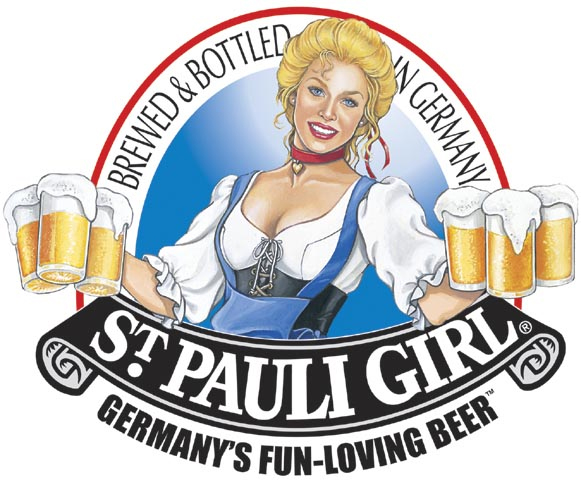
Hyndla compares Freyja to Heidrun, who runs "hot among the
he-goats". There is clearly a sexual side to the comparison. The
boar/warrior is her lover. The word "riða", as in Freyja 'rides' her
lover Ottar, also has a similar meaning in Icelandic slang. Sexual
intercourse is necessary to perpetuate the unending cycle of life
necessary to keep Valhall full.
If I may extend the poetic conceit, I would suggest that the
lactating she-goat is representative of a breast-feeding mother. It's
yet another symbol in the cycle of regeneration already expressed around
the Einherjar. The spiritual rebirth is also a physical birth. As
Heidrun keeps the einherjar hydrated, the lactating mother feeds her
newborn infant. At least one modern artist has envisioned Heidrun this
way:
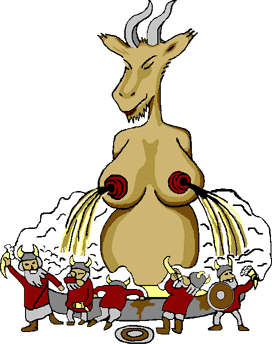
The symbolism is consistent and indicative of a regular
cycle, a ring with no beginning and no end. Life proliferates.
According to evidence preserved in the work of Jakob Grimm and elsewhere, the
boar is a sacred Yuletime (year-end) meal. Yule cakes are made in the shape of boars
(cp. modern Christmas cookies). The last sheaf of grain is feed to the Yule boar
before it is slaughtered, and the plowman is fed some of the Yule boar's
preserved meat in the Spring before plowing in German folk tradition. This
connects food-production directly to the annual cycle, and through the boar to
the sexual cycle as well. The warrior is compared
to the boar (as food). The Yule boar is served up with an apple, the symbol
of renewing youth, in its mouth. The symbols are consistent and
interlaced.
We may be touching on the heart of the religious mystery here. Both human and
boar have equivalent value in the Germanic
symbolism of
sacrifice. The boar is thus a powerful symbol in Germanic religion and
appears to represent the eternal rebirth of mankind. This interpretation fits
well with other examples from the lore.
He-goats draw Thor's car. Like the boar Sæhrimnir they can be slaughtered, eaten and brought to life
again, if their bones are laid unbroken on their flayed skins. When the whole heap is
hallowed by Thor's hammer (a phallic symbol according to many scholars), the goats stand up
again, reborn whole. Thor's goats
provide him and his travelling companions (his comrade in arms) a neverending supply of meat.
Human flesh is, of course, the "best of meats" (Grímnismál 18). Compared to
Sæhrimnir, human flesh is the unending supply opf meat that "feeds' the
Einherjar (i.e. increases their numbers, strengthens them). Similarly,
Heidrun, a she-goat, provides a neverending supply of mead (i.e. mother's milk) to the
human Einherjar. Those who eat and drink it are reborn anew each
day.
These are powerful indicators of a belief in reincarnation. The reversal of
gender may be significant as well. Heidun is female, Thor's goats Tooth-gnasher
and Tooth-grinder are male. Both meat and mead, both male and female are
necessary in the chain of life. It's a natural balance. This may also explain the
signifcance of the number three: two opposites unite to create a third. Man and
woman unite to create an infant. Opposites, brought together create a balanced
third. In the story of creation, heat and cold flow into the abyss, creating the
conditions necessary for life. The cold well Hvergelmir (male) in the
north and the warm well, Urdar brunn (female) in the south are located
on opposite sides of Mimir's well, from which "Mimameiðr, "Mimir's Tree" or
Yggdrassils askur (the world-tree, cf. Askur, the first man) rises. In
Gylfaginning, Snorri informs us that Mimir's well is located "where Ginnungagap
once was."
We commonly find gender reversal in contexts where order is upset and must be
restored. Consider when Skadi comes to Asgard to avenge her father Thjazi's
death. She comes dressed in armor, seeking revenge, as a male heir would. The gods
promise to make her laugh and to allow her to choose a husband from their ranks by the beauty of his feet alone. Like
female brides who are chosen for the beauty of their faces, the male gods are
also veiled. Skadi, the woman, selects her mate. Similarly, to make Skadi laugh,
Loki ties his testicles with a cord to the beard of a nanny goat. Each yells out
in the ensuing tug of war, until at last Loki falls (naked?) into her lap. Loki
thus emasculates himself by tethering his male sex organs to the beard (a male
attribute) of a female animal. The reversal of gender is obvious. This reversal
restores the balance. Similarly, Thor must go to the giant Thrym's dressed as a
bride, impersonating Freyja, to retrieve his stolen hammer. The hammer is often
interpreted as a phallic symbol which not only slays the sacrifice and kills
giants (who are called 'calves' in Þórsdrápa), but one which is also laid in the
lap (i.e. the vagina) of a new bride. The same hammer kills and resurrects
(through hallowing) Thor's goats, which are the polar opposite of the goat
Heidrun.
The fact that this interpretation incorporates and consistently explains various symbols
found in the Germanic religious sphere speaks strongly for its validity.
[PREVIOUS][MAIN][NEXT]
[HOME]